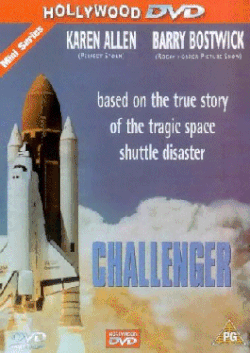Challenger (1990 film)
| Challenger | |
|---|---|

DVD release cover
|
|
| Written by | George Englund |
| Directed by | Ben Jordan |
| Starring |
Karen Allen Barry Bostwick Richard Jenkins Joe Morton Keone Young Brian Kerwin Julie Fulton Kale Browne Kristin Bond Angela Bassett |
| Theme music composer | David E. Cole |
| Original language(s) | English |
| Production | |
| Producer(s) | George Englund Courtney Pledger Debbie Robins |
| Release | |
| Original network | ABC |
| Original release |
|
Challenger is a 1990 American disaster drama television film based on the events surrounding the Space Shuttle Challenger disaster. Its production was somewhat controversial as the families of the astronauts generally objected to it. The film concentrates on the safety inspections and arguments surrounding the O-rings that ultimately were blamed for the explosion of Challenger. While doing this, it also aims to show the personal humanity of the seven crew members. Generally, the film supports the Space Shuttle program and the dedication of NASA personnel in general while criticizing NASA management.
In the film, NASA managers and Thiokol engineers argue back and forth about whether the data Thiokol has is adequate to support the risk they claim. In a teleconference, Morton Thiokol engineer Roger Boisjoly describes to the NASA team the soot from prior O-ring "blow-by" incidents on prior launches as "black", trying to communicate the severity of the malfunction, and says "it looked bad". A NASA director challenges him, asking "What does the black color mean?" Boisjoly, played by Boyle, is unable to put into words a concrete logical argument for concern about what is to him obviously a serious problem, and he just replies with something like, "I'm telling you, if you'd seen it, you'd know it isn't good." The NASA manager demands proof before he will ground the shuttle, and the call ends leaving Boisjoly frustrated and baffled at their attitude. Unable to prove their case with certainty, Thiokol managers cave in to direct pressure and reverse their recommendation, finally recommending launch.
On the human side, an interesting scene involves Christa McAuliffe talking with the designer of the "Teacher in Space" program, who enthusiastically describes to her his conception of a teacher performing experiments in space, while her students following along perform the same experiments on Earth and observe completely different results. He envisions this capturing their curiosity to stimulate an interest in science. She appreciates the vision, and the two have a very friendly, informal collegial conversation. He describes the complexity and great amount of effort that has gone into developing the "Teacher in Space" program, giving the example that an original plan involved a magnetism experiment with iron filings, but that that plan had to be changed due to risks: "What if those iron filings got out of their container? They could get into the equipment..." and cause a serious, dangerous equipment problem on board the shuttle. Everything has to be checked and planned and reviewed again; it's hard work, much harder than planning a regular daily lesson for a class on the ground. She understands and appreciates this, and is happy and excited to be a part of it.
...
Wikipedia
